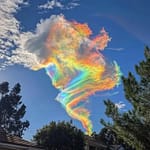Trivia Time:
- Lenticular clouds have been mistakenly identified as Unidentified Flying Objects (UFOs) in the past, but not limited to the past. Their curious shapes—resembling flying saucers—have led to UFO sightings and even fueled extraterrestrial speculation.
- Imagine someone glancing skyward, spotting a lenticular cloud, and whispering, “Quick, call Mulder and Scully!” It’s like the sky’s own cosmic prank. 👽
1. What Are Lenticular Clouds?
- Lenticular clouds (from the Latin word “lenticularis,” meaning lentil-shaped) form mostly in the troposphere. They’re like cosmic lenses or saucers suspended in the air.
- These clouds often appear stationary and parallel to the wind direction. Picture them as the sky’s way of saying, “Hey, Earthlings, check out my UFO impression!” 🌌🛸
2. How Do They Form?
- Imagine air flowing over mountains or hills, encountering obstructions that disrupt its flow. These disruptions create large-scale standing waves on the leeward side of the obstacle.
- If the temperature at the crest of these waves drops below the dew point, moisture in the air condenses to form lenticular clouds. Voilà! Instant cosmic saucers.
- Under certain conditions, long strings of lenticular clouds may form near the crest of each successive wave, creating a mesmerizing “wave cloud.”
3. Where Can You Find Them?
- Lenticular clouds generally avoid low-lying or flat terrain. They prefer the company of mountains and hills, where their lens-like shapes can truly shine.
- Bright colours (called iridescence) sometimes grace the edges of lenticular clouds, adding an otherworldly touch.
4. Flight and Soaring:
- Powered aircraft pilots tend to avoid flying near lenticular clouds due to turbulence and sinking air at the trailing edge. But glider pilots actively seek them out.
- Gliders use the upward-moving air at the leading edge of lenticular clouds to soar to remarkable altitudes. It’s like catching a cosmic elevator to the sky!
5. Height of Base:
- Lenticular clouds typically form between 6,500 and 16,500 feet above the ground. They thrive where the air is stable and winds flow across hills and mountains.
So, next time you gaze skyward, keep an eye out for these cloud oddballs. They’re the rebels with a meteorological cause—the UFOs of our atmosphere! 🌤️🔍🛸
Feel free to share this cloud curiosity on your WordPress blog—it’s like adding a dash of stardust to your readers’ day! ✨
Learn more about these celestial saucers and their high-altitude escapades! 🌦️🔍
Click Here For more cloud information click here or to return to our homepage here
Hi I am Marcus, MM0ZIF, a licenced Radio Amateur, Doctor of Musicology, amateur weather enthusiast. I over the years have been a Amateur Radio Tutor, Examiner, and a Regional Manager for the Radio Society of Great Britain.
This site is dedicated more towards Amateur Radio and Weather, with an angle on Technology too. I also maintain https://havenswell.com/ which is my other blog which is more aimed at cooking, hobbies and life in general as well as businness and networking.













